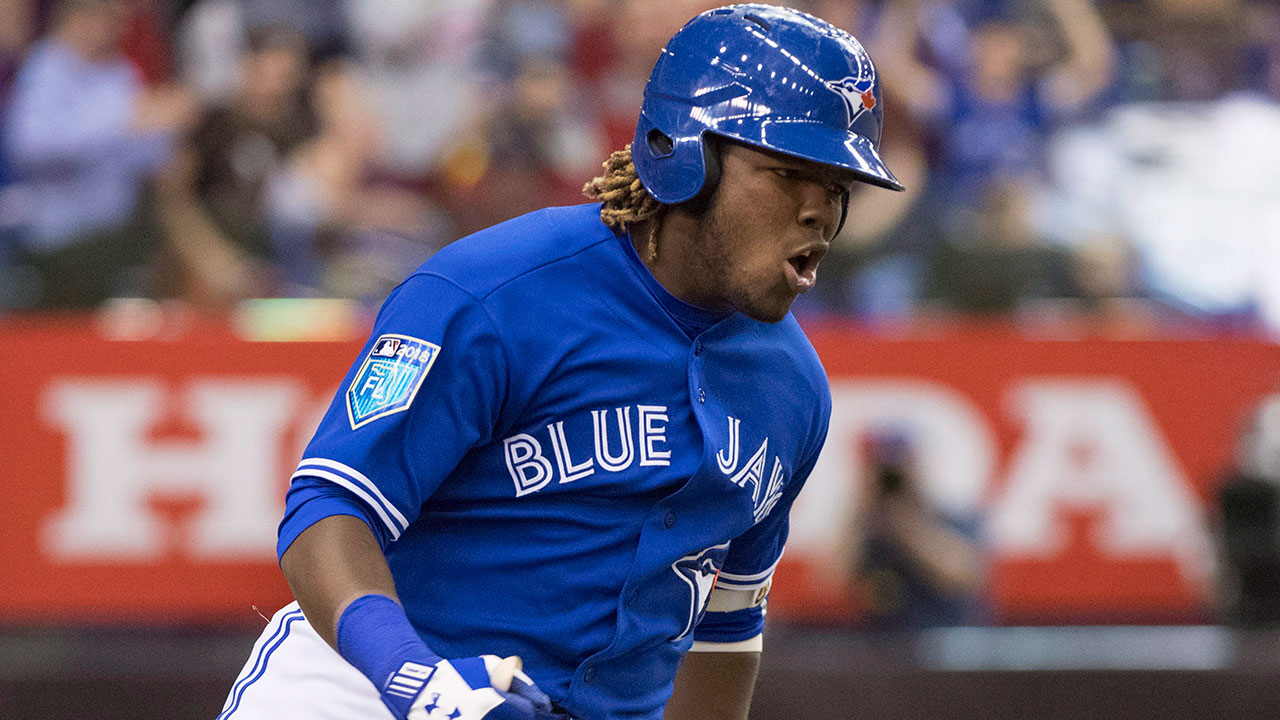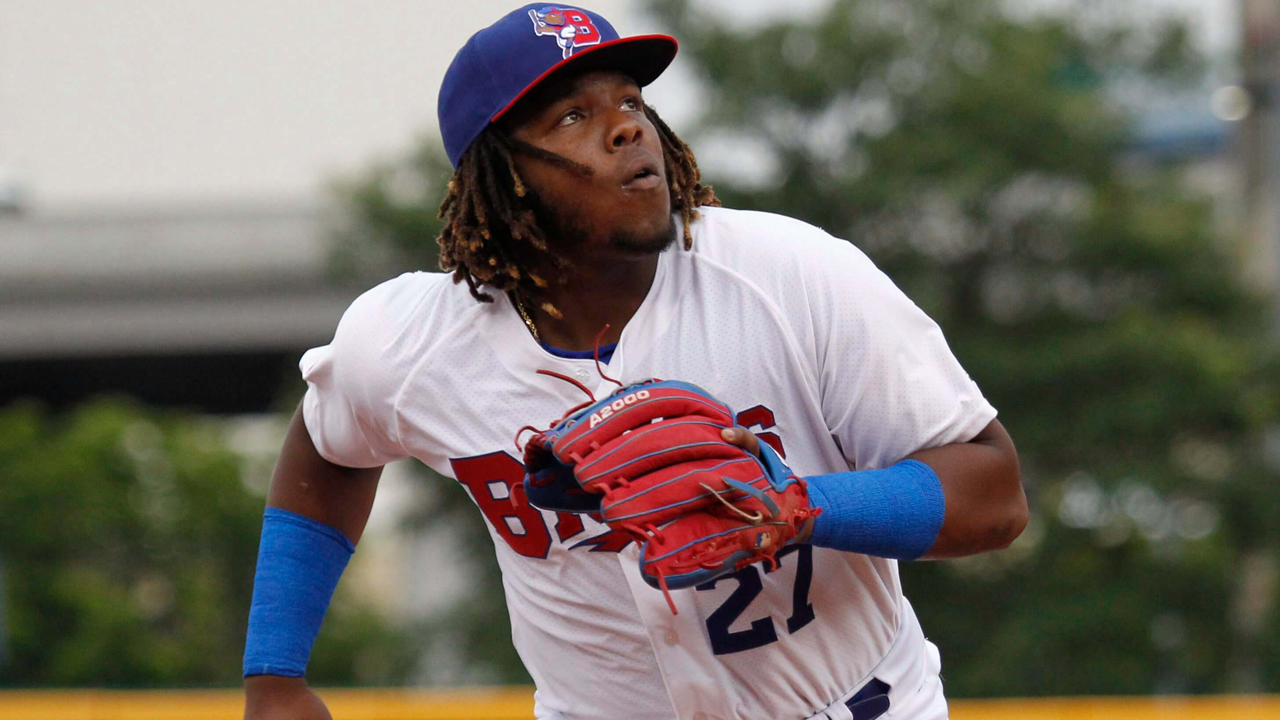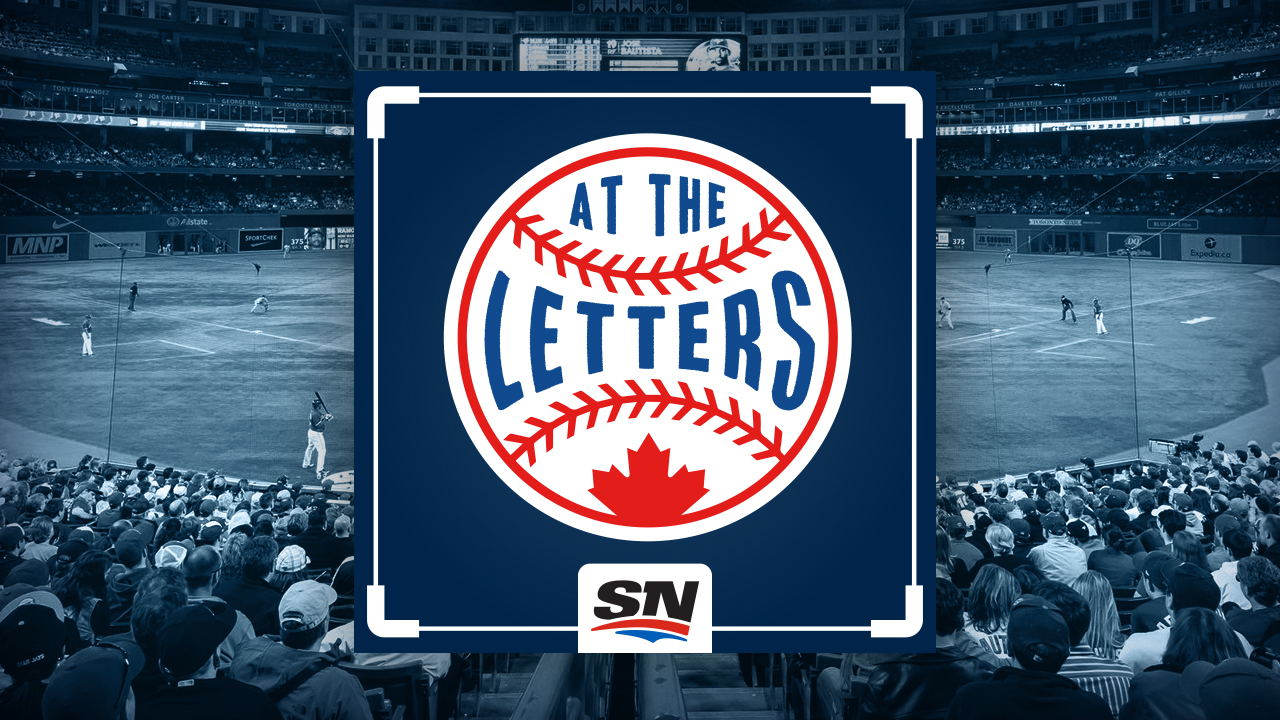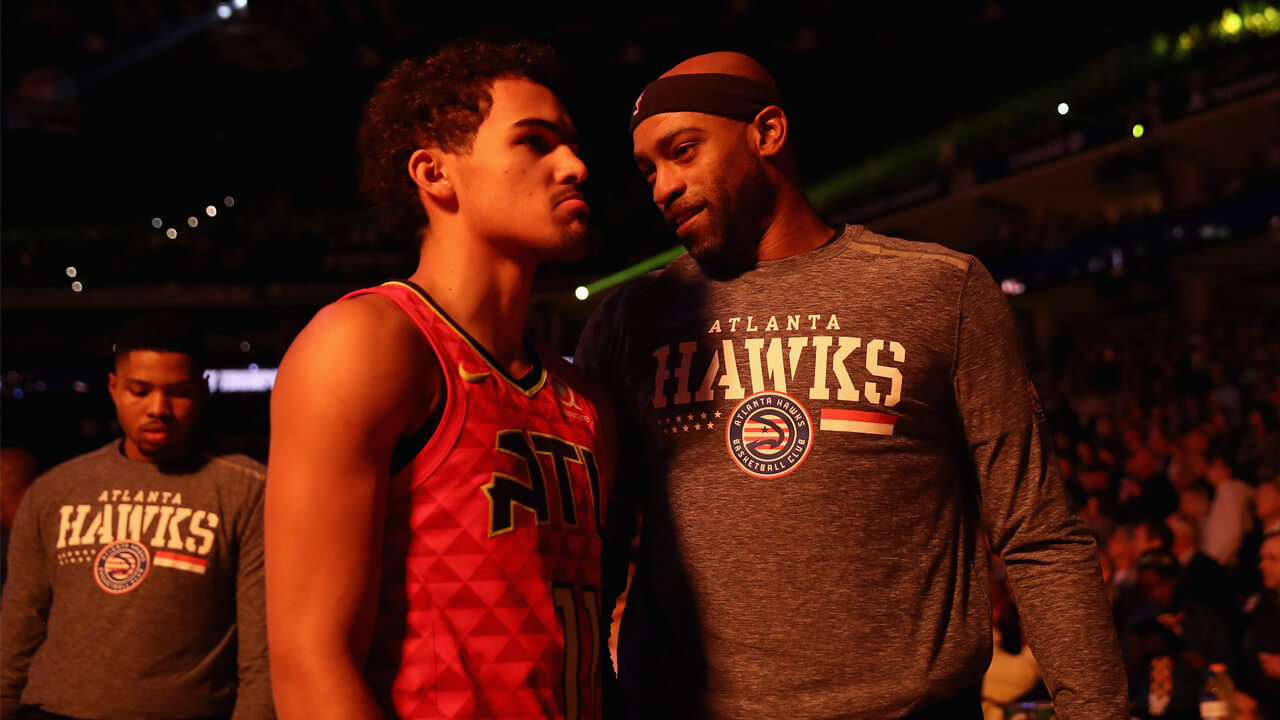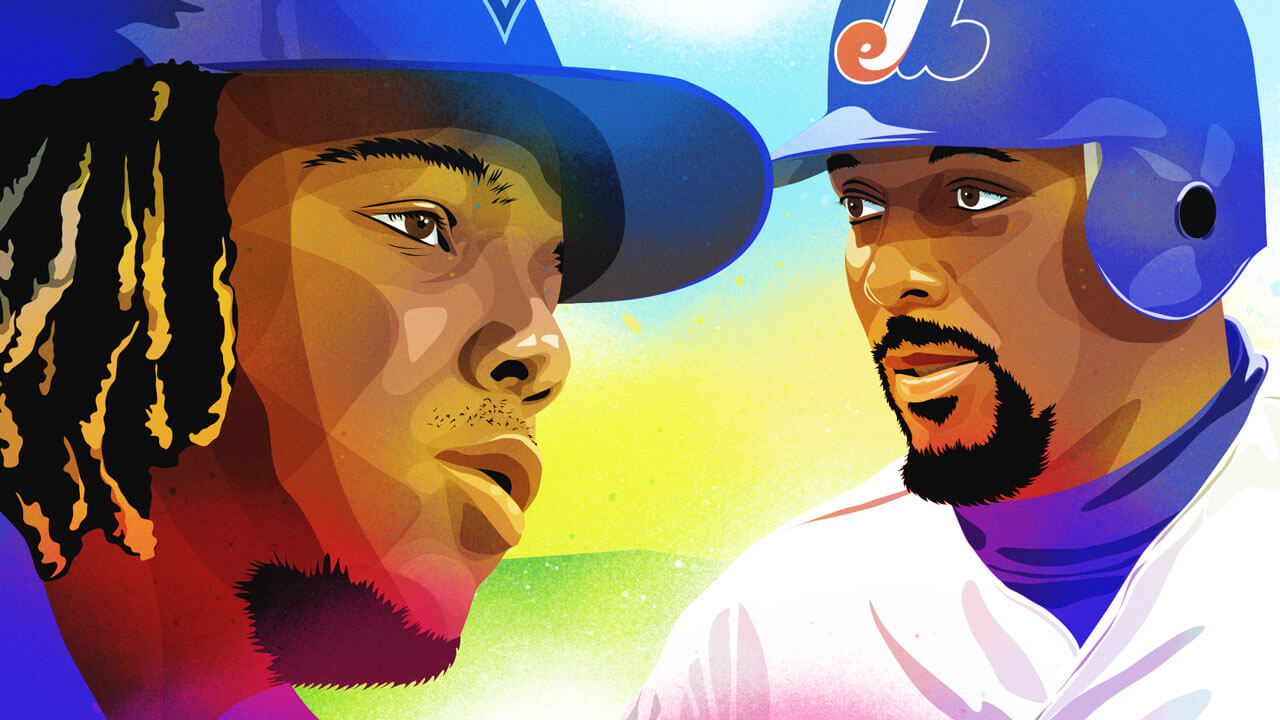He’s smiling as he swings the bat, but the movement is pure violence. Not only is he performing the Herculean task of launching baseballs from a tee over the opposite-field fence, he’s grinning as he does it. For Vladimir Guerrero Jr., this is light work.
It’s early May 2018 and Guerrero, wearing a Fisher Cats toque that conceals most of his gold-tinted dreads and a navy shirt aptly featuring a Toronto Blue Jays logo in the middle of a dumbbell, is the subject of an MLB Network video shoot at Northeast Delta Dental Stadium in New Hampshire. Carlos Pena, a former big leaguer, is serving as equal parts host and hype man, translating Guerrero’s words to the camera while egging him on with the colloquial Spanish expression plakata. Used by Pena since his childhood days in the Dominican Republic, plakata denotes good contact resulting in home runs, which are now coming in a barrage off the black barrel of Guerrero’s lumber. The word is discharged almost rapid fire.
Pena grabs the bat to see if he can go deep. After he fails, he removes the tee and proceeds to flip balls to Guerrero. Plakata. Plakata. Plakata. There’s a Hilton Garden Inn located just beyond the left-centre field fence and as the ferocious swings keep coming, guests sitting in front of the hotel are in danger, prompting cries of warning from Pena. Fortunately, no one is hit.
The only other time during Pena’s 17 years in pro ball that he witnessed such an impressive display of power came in 2001, when Alex Rodriguez was taking part in his first spring training with the Texas Rangers. Pena is careful not to make any comparisons, though, because he doesn’t think they’re fair. Rodriguez was 25 at the time and an established star, having just inked his name on the richest contract in the sport to that point. “Vladimir Guerrero Jr. is pretty much standing on his own island as far as a 19-year-old,” Pena says. “The sky is the limit with him.”
The video of Guerrero exploded on social media, not just in Toronto but across the baseball landscape. It was a key trigger in the onset of Vlad Mania, which reached frenetic heights over the following weeks as Blue Jays fans demanded their team call him up to the big leagues straight from double-A. The club didn’t, of course. Instead, Guerrero spent the rest of the summer providing ample proof that he deserves the mantle of the sport’s consensus top prospect.
Guerrero’s offensive potential is well documented. The son of a Hall-of-Famer, he is widely considered a generational talent. When he was in the low levels of the minors, evaluators were already declaring he could hold his own against MLB pitching. His prospect grades include an 80 hit tool (for comparison, Bryce Harper graded out as a 70 when he was 21) and Guerrero made good on that appraisal by Bachata dancing around the .400 mark this past season. Respected projection systems forecast elite big-league numbers from him as soon as 2019.
It’s unsurprising then that the conversation around Guerrero has always centred on skill. But as the viral performance of his video with Pena proved, Guerrero has plenty of potential off the field as well. “As a marketer, you’re attracted to him,” says Sunny Pathak, who operates in that field as president of NewPath Sports and Entertainment. “It’s going to be so fun to watch this guy when he comes up.”
Vladimir Guerrero Jr. will arrive in Major League Baseball as the most highly regarded Blue Jays prospect ever. It’s already understood that he’s the face of that team, even if the words aren’t yet publicly uttered in Toronto. The scrutiny of a player of that calibre doesn’t end when he steps outside of the foul lines — just ask Mike Trout, who’s been personally criticized by commissioner Rob Manfred for his seeming reluctance to become a true crossover superstar. Guerrero will have to be comfortable living under a microscope, but that position will offer him huge opportunities as well, especially if he can continue to improve his English. So, what is his off-field ceiling? And what does Guerrero have to do to reach it?
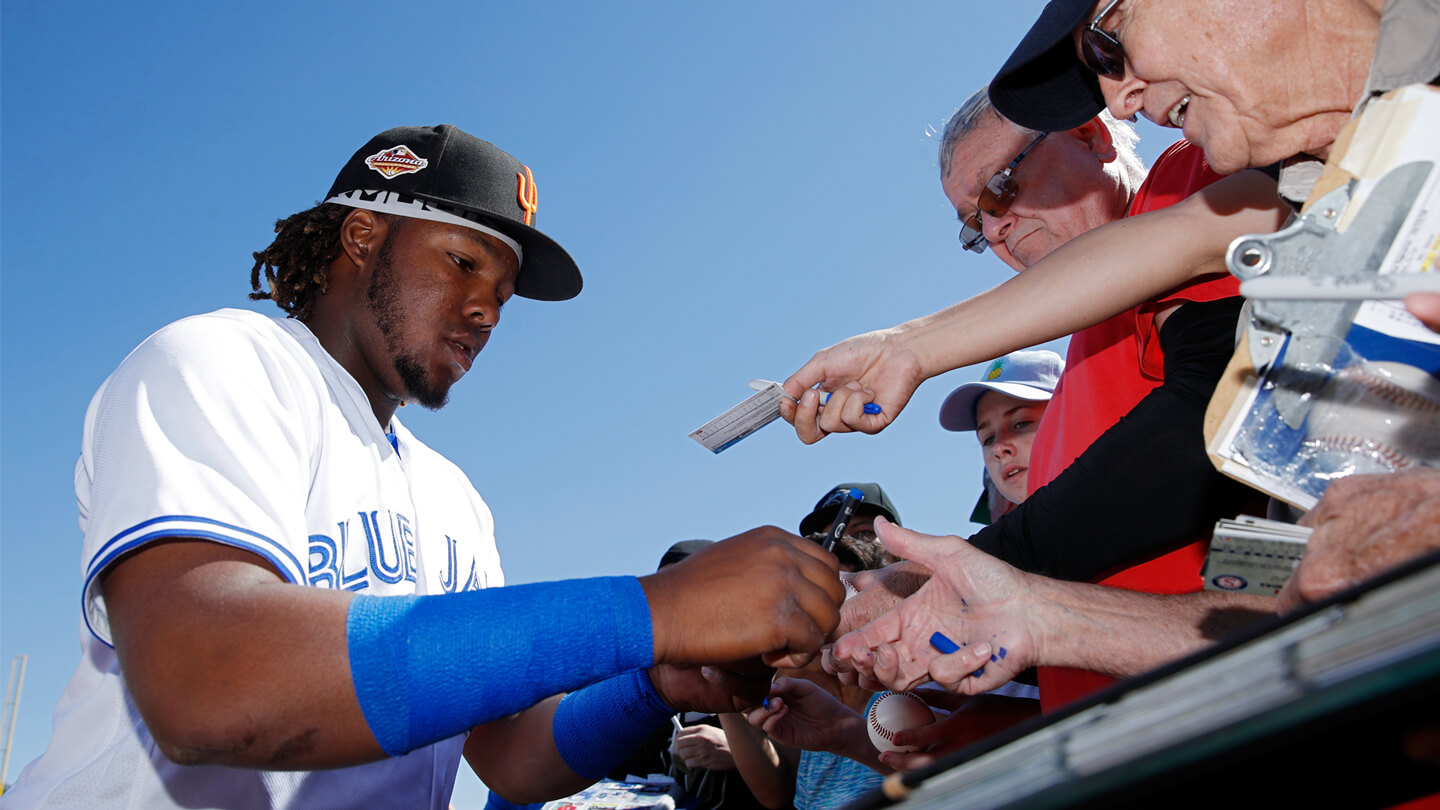
The simple act of turning his cap backward said so much about Ken Griffey Jr. the person. On the field, his five-tool talent spoke for itself. Members of the Seattle Mariners front office knew shortly after they drafted him first overall in 1987 that he was a special player who could excel in any era. And early in Griffey’s big-league career, then-Mariners general manager Woody Woodward began to realize the luminous reach of his star power.
Griffey routinely flipped his hat around during batting practice and, most famously, in the home run derby. Woodward quickly noticed the impact of that seemingly small decision. “He was really the first guy to do that,” Woodward says. “It was like he was playing in the backyard, and other players started to mimic what he was doing. At that point, you said, ‘Oh my, this guy is going to go way beyond being good.’ That’s the point where I knew this guy would be one of those [players] that youngsters around the country were watching.”
The backward cap is part of the abiding image of Griffey; it perfectly encapsulated the ease, confidence and style of his on-field personality. His grin was infectious, relaying the warmth and delight of someone doing what he loves. “He definitely had the smile and the joyful demeanour that everybody gravitated to,” says former teammate Joey Cora. “Seems like he was always happy and had no troubles in the world. He enjoyed the game. He made the game a game, not a job. That’s what drove his whole career.”
Such vibrancy, combined with gaudy numbers and performance, led to all kinds of crossover opportunities for Griffey. He had his own signature Nikes and a video game named after him, and even appeared on one of the hottest sitcoms of the early ’90s, The Fresh Prince of Bel-Air. Guerrero has some ways to go before he earns a sneaker deal or television appearance, but he’s already got one part of the equation down: The effervescent smile and joyfulness. Teammates and coaches have raved about his positive attitude and jovial aura. Pena confirms all of the above, having noticed the traits during the MLB Network filming.
If Guerrero can maintain his buoyant energy, opportunities will come. When they do, he’s got to want them. “I think it takes a special personality to do that,” says Lee Pelekoudas, a former assistant GM with the Mariners. “Vlad Guerrero Jr. could be the most talented guy in the world. But part of the blueprint is having a willingness to go out there and be the face of baseball — and have the personality to do it.”
One hardly needs to put on a lab coat and examine strands of DNA to find out where such charisma comes from. Pelekoudas believes that for Griffey, the freedom he operated with can be at least partially attributed to growing up around the big leagues. Griffey’s father was a veteran of 19 MLB seasons, so Junior always had an insider’s view of life at the highest level of baseball. Pelekoudas, whose father was a National League umpire for 16 years, says that upbringing can ease the nerves of a young person so that they’re rarely star-struck and can act more natural and relaxed, free to let their own talent take over.
Guerrero, of course, is also the son of a big leaguer and was a fixture around MLB clubhouses in Montreal and Los Angeles, the cities where Vladimir Guerrero Sr. spent most of his career. Coming from a baseball family can create a rock-solid foundation that informs the decisions a young player makes, according to Woodward. His tenure as Mariners GM featured a team that fielded both Griffey and Alex Rodriguez, who was arguably just as talented as the Kid, yet was never as beloved by fans. “Alex did not come from that solid of a baseball background,” Woodward says. “And he looked for guidance when he was developing — as all players do when they’re young. They look for somebody in the clubhouse to help them as they grow. He didn’t have that family background that Junior had through those early years.
“I would say that prepared Griffey and gave him a more solid background at an early age than any ballplayer, not just Alex,” Woodward continues. “Griffey was well schooled.”
Not to be forgotten in Griffey’s story is the lesson that a crossover superstar didn’t have to be stationed in a major media market. Seattle doesn’t garner the spotlight of New York or L.A. This is important when considering the case of Guerrero in Toronto, a city where the pro teams have often struggled to capture and hold the attention of U.S. audiences. The Blue Jays aren’t a small-market franchise, but they’ve been treated like one — an attitude that may have stopped the likes of Roberto Alomar, Carlos Delgado and Roy Halladay from reaching even greater heights. If there’s a worry that geography could limit Guerrero’s star power, look no further for reassurance than the smiling superstar in the backwards cap.
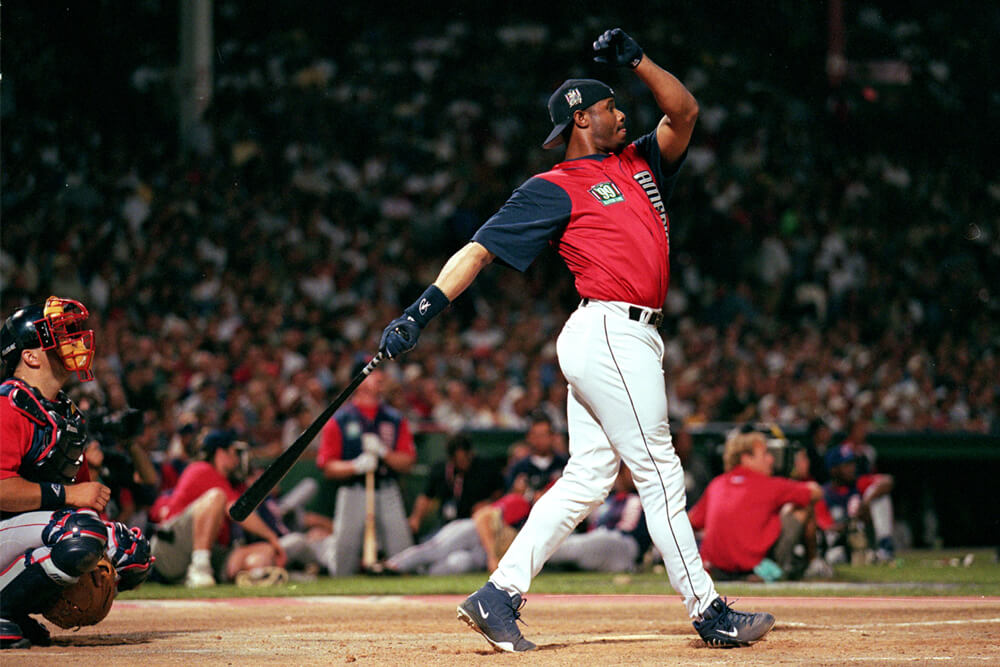
Derek Jeter’s first visit to The House That Ruth Built as a member of the Yankees came in 1992, soon after the team drafted him. A tour of the stadium included a stop by the manager’s office in the home clubhouse, where the 18-year-old Jeter, along with his parents and sister, met skipper Buck Showalter.
The following day, team radio announcer Michael Kay asked Showalter what he thought of the new draft pick. The manager responded that he had never seen Jeter play, but after spending time with his mother and father, Showalter could assure Kay of one thing: Jeter would never, ever, embarrass the organization.
As the shortstop matured into a fabled captain of the franchise, one of his defining characteristics was the ability to avoid saying or doing the wrong thing — no matter the circumstance. He never put himself or his team in a bad light, and even on the rare occasion he erred, Jeter managed to right things and end up in better shape than before.
When Yankees owner George Steinbrenner publicly criticized Jeter in 2002, saying he lacked focus because he was staying out late enjoying the New York nightlife, the comments were a source of tension. But just a few months later, the pair poked fun at the incident in a memorable Visa commercial that extinguished any embers and advantageously showed off Jeter’s sense of humour. Jeter’s Law it seems, was the opposite of Murphy’s.
He was also a master at handling the unrivalled demands of the New York media. “The interesting thing with Derek was that when he was interviewed, he was never that interesting,” recalls Kay, who’s now a Yankees play-by-play broadcaster on the YES Network. “He never really had anything controversial to say. He was never a great quote, never a great soundbite, but that played in his favour because he kept a lot of the inside stuff to himself. So, what he showed the world was what he wanted to show the world, and he just had almost a sixth sense on how to do that.”
Guerrero, in his limited dealings with the press, has proven similarly adept. When reporters descended on Buffalo this past summer like anglers to a sea wall, Guerrero had every opportunity to take the bait. Despite his domination of double-A, then triple-A, the Blue Jays didn’t summon him to the majors, delaying the start of his service clock, and keeping him under club control for longer. If that decision upset Guerrero, he didn’t let it show, despite having every opportunity to publically criticize the organization’s decision making. Instead, he switched lanes away from potential controversy at every encounter, revealing little in interviews without coming off as standoffish or difficult. “For the public to love you, you have to wish [for] their adulation and you have to be lovable yourself,” says John Thorn, MLB’s official historian. “You can’t be ornery and cantankerous and have your PR flacks project a personality different from the one you have.”
While a study of Jeter can provide an easy-to-follow manual for how to deal with the press, it’s harder for Guerrero to emulate the other factor that made No. 2 such a recognizable figure. Jeter was the central character on a Yankees dynasty; that, more than anything else, made him a household name. “If Derek had that same career in Kansas City and didn’t win the five championships, we probably would not have thought of him as the face of baseball,” Kay says.
Winning one ring, much less a handful, is obviously out of Guerrero’s individual control. But there’s hope the Blue Jays can be successful during his early 20s. The club is currently in a retooling phase and, as of August, boasted the third-best farm system in the game, according to Baseball America. Whether a championship core can grow from that remains to be seen, but president Mark Shapiro did say recently that once a foundation is formed, payroll will likely increase to bring in additional talent.
In the meantime, Guerrero can only focus on himself and in doing so, learn from Griffey and Jeter, who represent two different approaches to baseball stardom. One had supreme talent and a buoyant personality, while the other carried himself with immense professionalism and won. What they both shared, though, was marketability.

If the patterned, red-and-black sweater didn’t catch a reader’s eye, then the tan overcoat or suave black turtleneck certainly did. When Auston Matthews appeared in a GQ magazine piece prior to the start of this NHL season, people saw the Toronto Maple Leafs centre in a completely different light — posing in high-end designer garb, while discussing Tom Ford cologne and Louis Vuitton duffel bags.
The 21-year-old is a burgeoning superstar and the article, according to his agent, Judd Moldaver, was a good fit for his personality. “You try and curate your client’s opportunity to their interests,” says Moldaver, senior vice president of hockey at Wasserman. “Auston happens to be, while not limited to this, very interested in fashion. Therefore, that becomes an easy thing to think about. When a client expresses interest in a certain field, you want to try and explore that field.”
There are obvious similarities between Matthews and Guerrero: the centreman was hailed as a franchise saviour when he entered the league, and the hope was that he would deadlift the Maple Leafs off the floor; when Guerrero enters MLB next season, the same expectations will be pinned on him. Both players are also a marketer’s dream.
While he has progressed on the ice over his two-plus NHL seasons, Matthews’s endorsement portfolio has remained relatively quiet, with just Scotiabank, Bauer and Fanatics as prime partners. Alignment with such well-established brands is preached by the MLB Players’ Association (though the PA tries not to wade too far into the decision making of its members). “We want the player to affiliate with high-quality brands that don’t cut corners, have sound business planning and are thoughtful in their marketing to consumers,” says Timothy Slavin, MLBPA’s chief of business affairs and licensing senior counsel. “For its part, the MLBPA is pushing very hard to get household brands aligned with players.”
The process of seeking out such opportunities is critical for Guerrero if he’s to grow into a true crossover star. Pathak, the NewPath sports marketer, has consulted with brands such as American Express, Levi’s and Nike, and worked on partnerships with several Toronto-based athletes, including Kevin Pillar, Marcus Stroman and Delon Wright. He says the Guerrero family story offers plenty of meat.
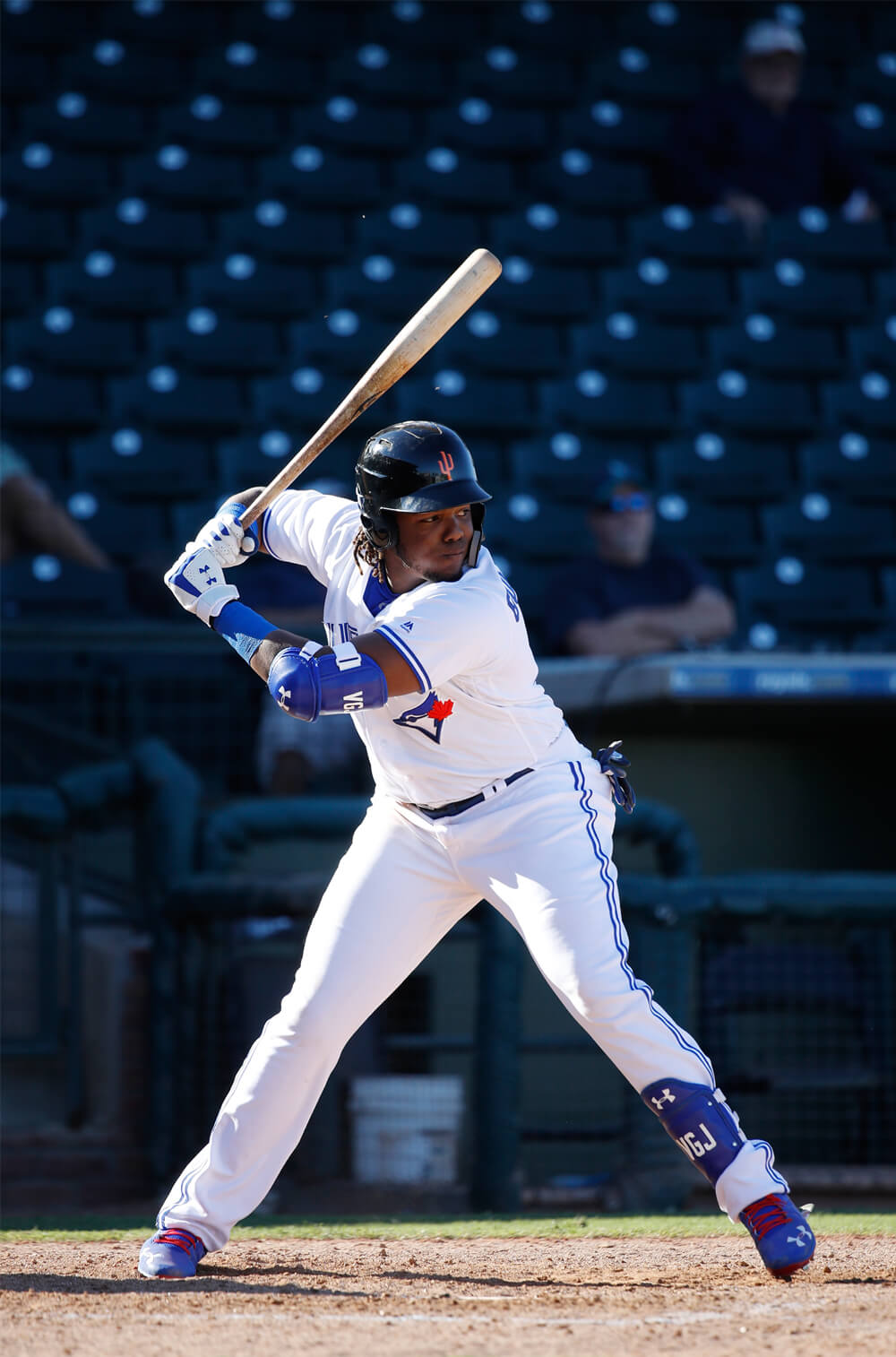
It’s well known that Altagracia, mother of Vladimir Guerrero Sr., cooked and cared for her son when he played in Montreal. Years later, as her grandson’s pro career took him through various cities in the Blue Jays’ farm system, she kept an eye on him every step of the way. “There’s this amazing story for a brand when the time is right,” Pathak says. “To tell this story of family; meals shared together with a father and a son and a grandmother.”
Of course, communication is a key part of any athlete’s endorsement responsibilities and for Guerrero, that will eventually need to be done in English. He’s said to have working knowledge of the language and is constantly trying to firm up his grasp on it. The progress was evident during his recent acceptance speech at MLB’s Winter Meetings in Las Vegas, where he was presented with the 2018 Baseball America Minor League Player of the Year award. However, marketers and agents don’t believe a lack of proficiency will hinder his opportunities, at least in the early going. There are several examples of foreign athletes appearing in advertisements and saying few words, with perhaps the most notable example being Cristiano Ronaldo in American Tourister commercials. There are even recent examples in baseball, Pathak points out, such as Yankees phenom Gleyber Torres — a Venezuelan with limited English — holding an endorsement partnership with Toronto-based BioSteel Sports.
Language matters less on social media, where Guerrero will also attract both fans and brands. He already has 232,000 Instagram followers, despite having never suited up in a big-league game. That figure is just behind the 247,000 that Torres boasts and ahead of the 227,000 belonging to Ronald Acuna Jr., the reigning NL Rookie of the Year and baseball’s former consensus top prospect. Companies consider the number of followers, comments and engagement that an athlete produces as key performance indicators — major predictors of marketing power — and also scour accounts for any hint of controversy. Guerrero has been clean on that front, but did commit somewhat of a gaffe during Vlad Mania last year when he posted an Instagram photo that was geotagged to JFK Airport, causing frenzied fans to believe he was joining the Blue Jays, who were in New York to play the Mets. It was quickly deleted from Guerrero’s account, and one can surmise that the incident proved an instructional experience for him about the social media clout he wields.
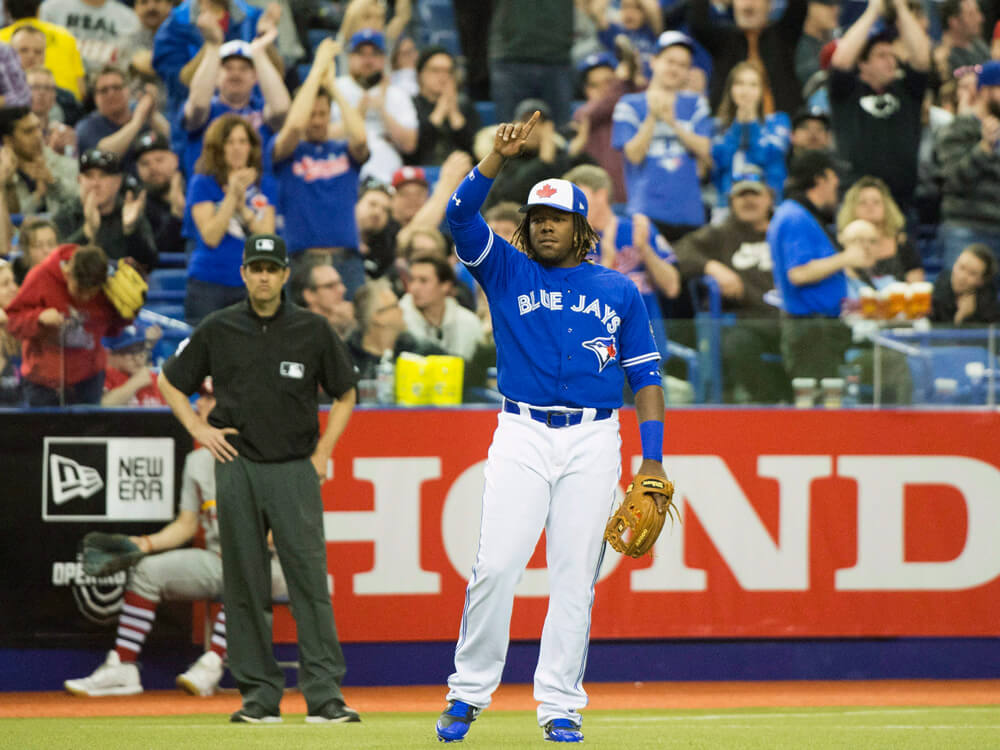
Pena was concerned about Guerrero wearing himself out during their shoot in New Hampshire. The Fisher Cats had a game that evening and the prospect was set to man third base. Maybe he should ease up on all these vicious swings, Pena thought. When he brought it up, Guerrero immediately waved away the idea. “Why are you so worried?” he asked in Spanish. “This is my routine. When I’m stressed, I hit balls off the tee. When I need to relax, I hit balls off the tee.”
Reflecting back on that conversation, Pena insists the teenager wasn’t bragging. Instead, he was simply in his element. “I noticed his ease in front of a camera and his ease with the attention that he was getting,” says Pena. “He was not overwhelmed by it. Not even a bit. At the same time, he displayed this humility that was, in a sense, enchanting. When you’re that dominant in the minor leagues, I would assume the opposite — that you would walk with a sense of entitlement.”
In the game that night, Guerrero launched two home runs, including a rocket that made contact with the Hilton Garden Inn. Following the contest, he made sure to send Pena a simple text message: Plakata!
It’s just one word, but it might as well have been a paragraph, at least in Pena’s eyes. “It’s like, ‘I can have fun, I can enjoy being in the limelight. But when it’s business time, let’s drop some head [the barrel of the bat] on some baseballs,’” says Pena. “That’s exactly what he did … He blossomed under the lights.”

